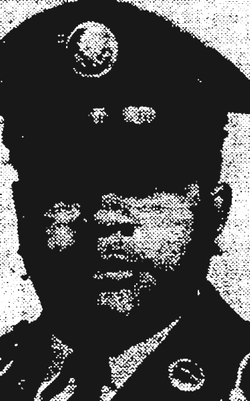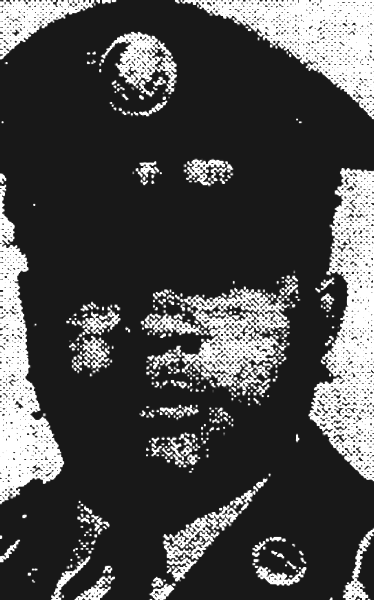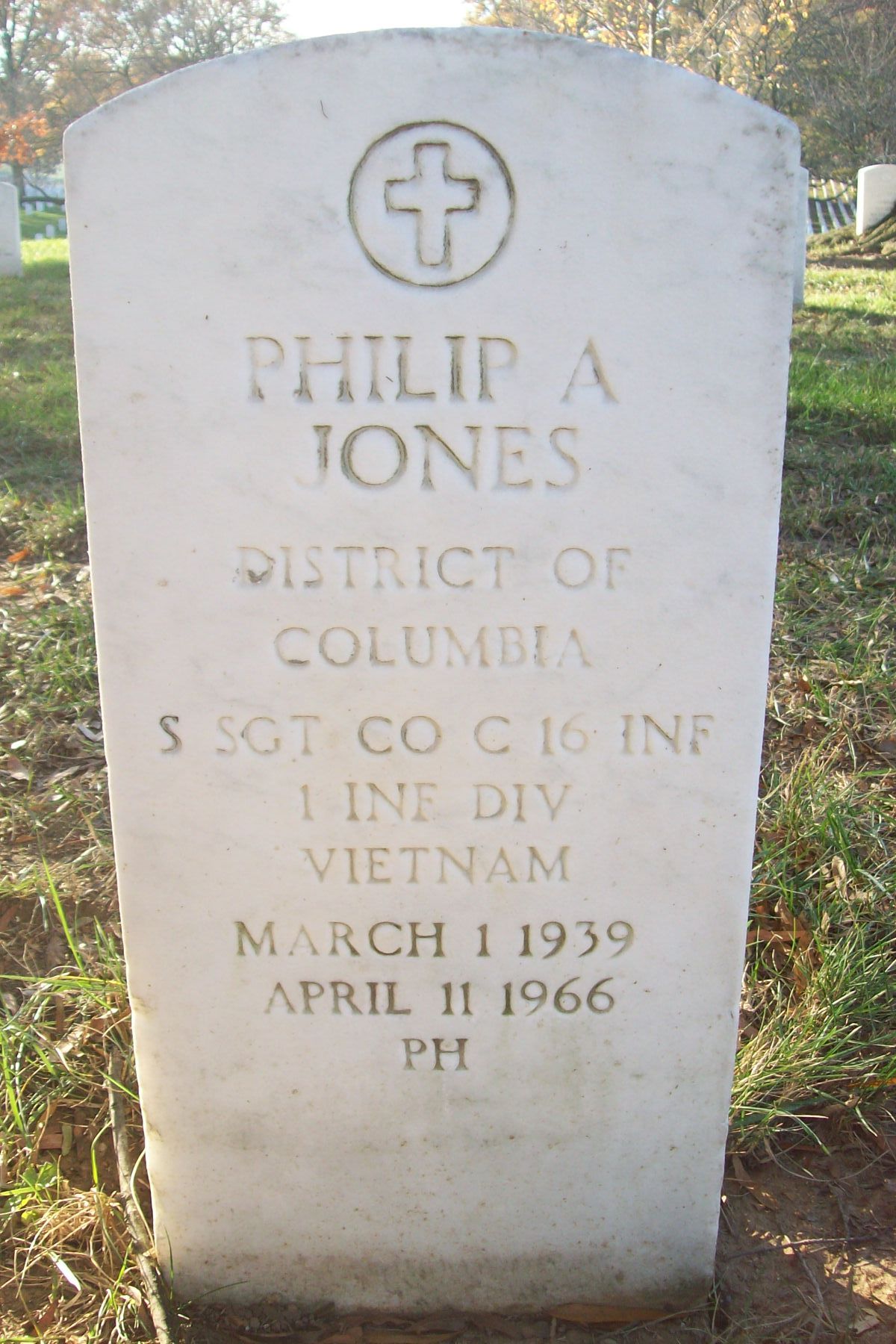MOS:
SSgt Jones died as a result of multiple fragmentation wounds to the body from a hostile explosive device during Operation Abilene in Phuoc Tuy Province.
Survived by his wife and children.
==========
The Battle of Xa Cam My was fought over two days during April 11–12, 1966, 10 miles south of the village of Cam My in Phuoc Tuy Province, RVN. Originally planned as a U.S. search and destroy mission intended to lure out the "crack" Viet Cong D800 Battalion, Charlie Company, U.S. 2/16th Infantry Battalion soon found itself fighting for survival in the rubber plantations of Cam My village, approximately 42 miles east of Saigon. During this battle, 134 men of Charlie Company, 2nd Battalion, 16th Infantry, 1st Infantry Division, were ambushed by the Viet Cong and 80 percent became casualties. Major General William E. DePuy, as commander of the U.S. 1st Infantry Division, planned to lure out the Viet Cong by using Charlie Company as a bait. As Charlie Company moved through the Courtenay Rubber Plantation, they encountered sporadic fire with Viet Cong snipers attempting to knock the Americans off one by one. The sporadic fire allowed the Viet Cong to maneuver around the outnumbered Americans. By 2:00 PM, VC officers were spotted around the positions of Charlie Company, directing the encirclement of U.S. positions. By that time it had become clear that the Viet Cong had taken the bait. However, DePuy's gamble on other rifle companies arriving to assist was thwarted by the thick jungle. To minimize casualties and break the ambush, Charlie Company formed a circular perimeter with interlocking fire. The situation deteriorated as Charlie Company found itself increasingly isolated with only a distant hope of reinforcement. This was made worse when misdirected artillery fired upon Charlie Company instead of the aggressive VC forces. The fighting continued well into the night, with the desperate Charlie Company throwing all it had at the determined Viet Cong using tear gas grenades. However, their efforts were not enough to stop the Viet Cong from breaking through their lines. Through the night, small units from the Viet Cong D800 Battalion breached the American perimeter, retrieving their own casualties and killing American wounded. After five hours of brutal fighting, what was left of Charlie Company formed a tight perimeter, protected by a barrage of artillery fire which came down at a rate of five or six rounds per minute. By 7:00 AM on April 12th, the Viet Cong had disengaged from the battle before other U.S. units could arrive. American losses numbered 37 killed and 70 wounded, while the Viet Cong left 41 dead on the field, more than 80 killed and wounded removed. Two posthumous Medals of Honor were awarded in connection with this battle, SGT James W. Robinson Jr. and A1C William H. Pitsenbarger, the latter awarded in December 2000. The other lost Americans included PFC Marion F. Acton, SP4 Howard C. Blevins, PFC Carl D. Buckley, PFC Andrew J. Campbell, SGT William H. Causey, SSGT Ralph Coleman, PFC John A. Davis, SP4 Donald E. Dermont Jr., PFC Dennis A. Desco, PFC Philyaw Fee, SP4 Eugene Garrett Jr., PFC Edward L. George, SSGT Bozy Gerald, PFC David A. Hammett, PFC Charles E. Harvey, PFC Norman L. Hawkins, PFC Robert A. Johnson, SSGT Philip A. Jones, PSGT Everett E. Langston, SGT Richard J. Manley, PVT Emmitt Mays Jr., SP4 Charles D. Oglesby, SP4 Randall B. Prinz, PFC Edward W. Reilly, SGT Ronald J. Seasholtz, SP4 Henry A. Shiver, PFC J.C. L. Short, PFC Joseph F. Smith, PFC Thomas D. Steele, CPT George C. Steinberg, PFC Deane S. Van Dyke Jr., PFC Daniel E. Walden, PFC George H. Ward, PFC John W. Watkins, and SGT Irving M. Wilson Jr. [Taken from coffeltdatabase.org and wikipedia.org]
MOS:
SSgt Jones died as a result of multiple fragmentation wounds to the body from a hostile explosive device during Operation Abilene in Phuoc Tuy Province.
Survived by his wife and children.
==========
The Battle of Xa Cam My was fought over two days during April 11–12, 1966, 10 miles south of the village of Cam My in Phuoc Tuy Province, RVN. Originally planned as a U.S. search and destroy mission intended to lure out the "crack" Viet Cong D800 Battalion, Charlie Company, U.S. 2/16th Infantry Battalion soon found itself fighting for survival in the rubber plantations of Cam My village, approximately 42 miles east of Saigon. During this battle, 134 men of Charlie Company, 2nd Battalion, 16th Infantry, 1st Infantry Division, were ambushed by the Viet Cong and 80 percent became casualties. Major General William E. DePuy, as commander of the U.S. 1st Infantry Division, planned to lure out the Viet Cong by using Charlie Company as a bait. As Charlie Company moved through the Courtenay Rubber Plantation, they encountered sporadic fire with Viet Cong snipers attempting to knock the Americans off one by one. The sporadic fire allowed the Viet Cong to maneuver around the outnumbered Americans. By 2:00 PM, VC officers were spotted around the positions of Charlie Company, directing the encirclement of U.S. positions. By that time it had become clear that the Viet Cong had taken the bait. However, DePuy's gamble on other rifle companies arriving to assist was thwarted by the thick jungle. To minimize casualties and break the ambush, Charlie Company formed a circular perimeter with interlocking fire. The situation deteriorated as Charlie Company found itself increasingly isolated with only a distant hope of reinforcement. This was made worse when misdirected artillery fired upon Charlie Company instead of the aggressive VC forces. The fighting continued well into the night, with the desperate Charlie Company throwing all it had at the determined Viet Cong using tear gas grenades. However, their efforts were not enough to stop the Viet Cong from breaking through their lines. Through the night, small units from the Viet Cong D800 Battalion breached the American perimeter, retrieving their own casualties and killing American wounded. After five hours of brutal fighting, what was left of Charlie Company formed a tight perimeter, protected by a barrage of artillery fire which came down at a rate of five or six rounds per minute. By 7:00 AM on April 12th, the Viet Cong had disengaged from the battle before other U.S. units could arrive. American losses numbered 37 killed and 70 wounded, while the Viet Cong left 41 dead on the field, more than 80 killed and wounded removed. Two posthumous Medals of Honor were awarded in connection with this battle, SGT James W. Robinson Jr. and A1C William H. Pitsenbarger, the latter awarded in December 2000. The other lost Americans included PFC Marion F. Acton, SP4 Howard C. Blevins, PFC Carl D. Buckley, PFC Andrew J. Campbell, SGT William H. Causey, SSGT Ralph Coleman, PFC John A. Davis, SP4 Donald E. Dermont Jr., PFC Dennis A. Desco, PFC Philyaw Fee, SP4 Eugene Garrett Jr., PFC Edward L. George, SSGT Bozy Gerald, PFC David A. Hammett, PFC Charles E. Harvey, PFC Norman L. Hawkins, PFC Robert A. Johnson, SSGT Philip A. Jones, PSGT Everett E. Langston, SGT Richard J. Manley, PVT Emmitt Mays Jr., SP4 Charles D. Oglesby, SP4 Randall B. Prinz, PFC Edward W. Reilly, SGT Ronald J. Seasholtz, SP4 Henry A. Shiver, PFC J.C. L. Short, PFC Joseph F. Smith, PFC Thomas D. Steele, CPT George C. Steinberg, PFC Deane S. Van Dyke Jr., PFC Daniel E. Walden, PFC George H. Ward, PFC John W. Watkins, and SGT Irving M. Wilson Jr. [Taken from coffeltdatabase.org and wikipedia.org]
Sponsored by Ancestry
Advertisement
Explore more
Sponsored by Ancestry
Advertisement




